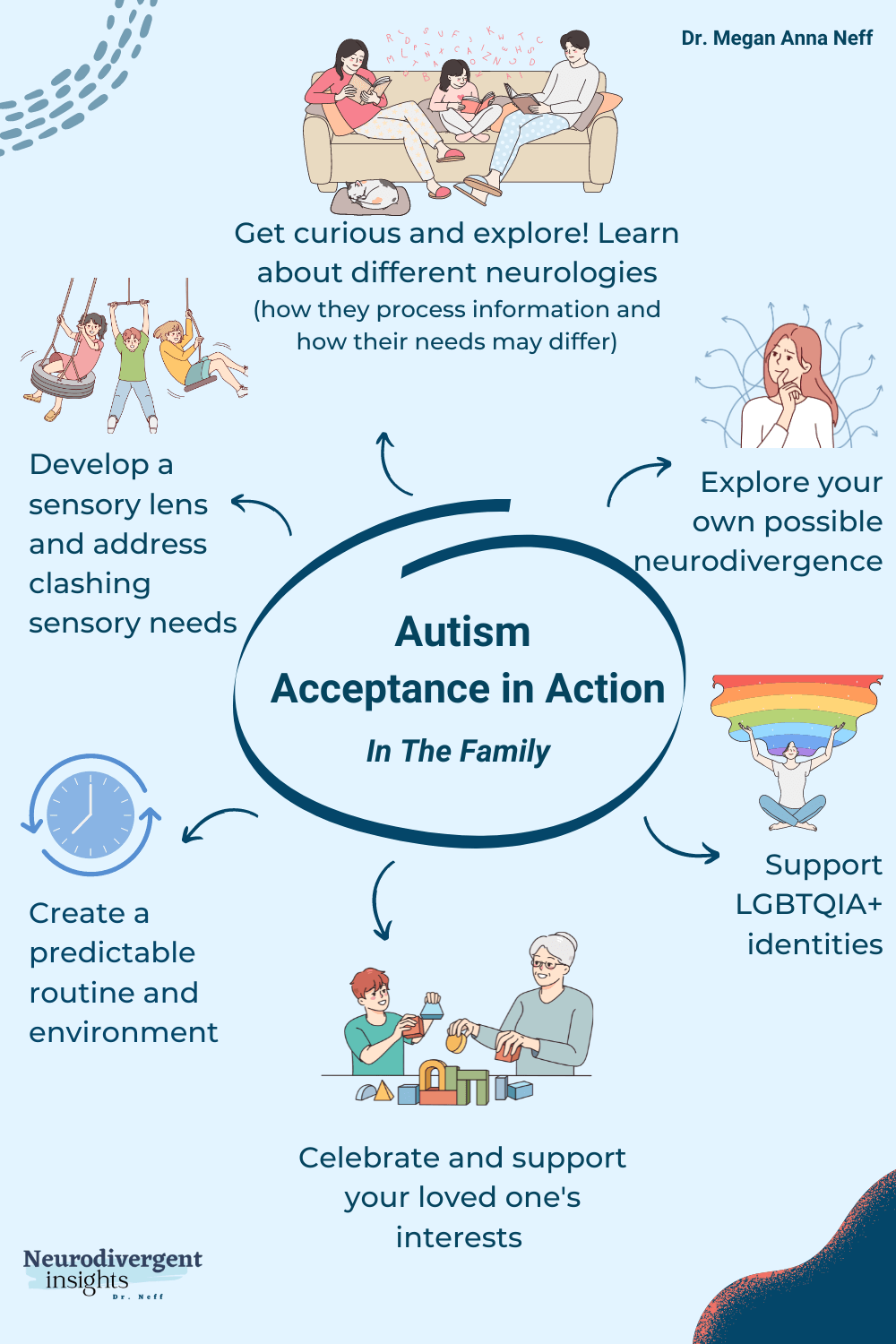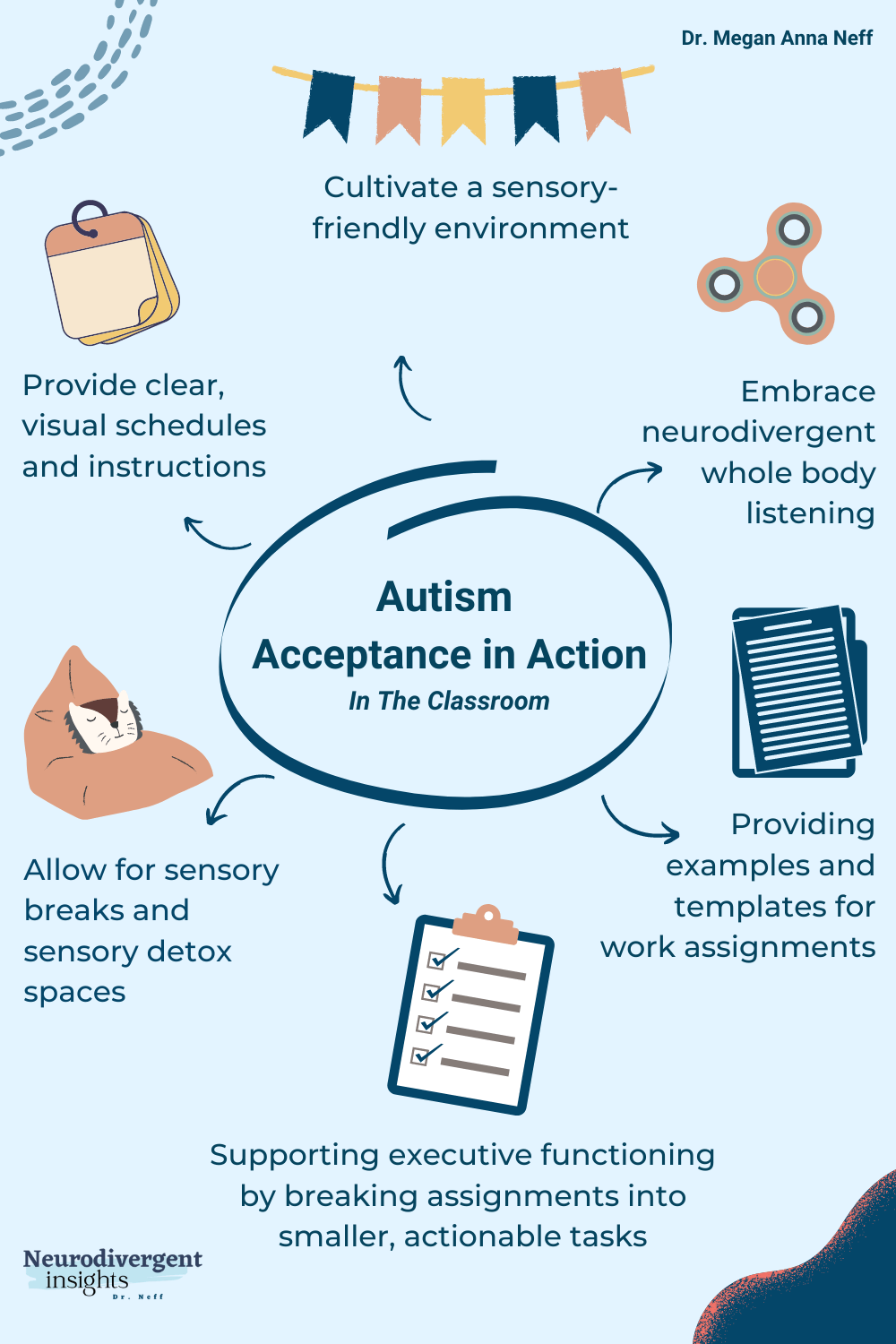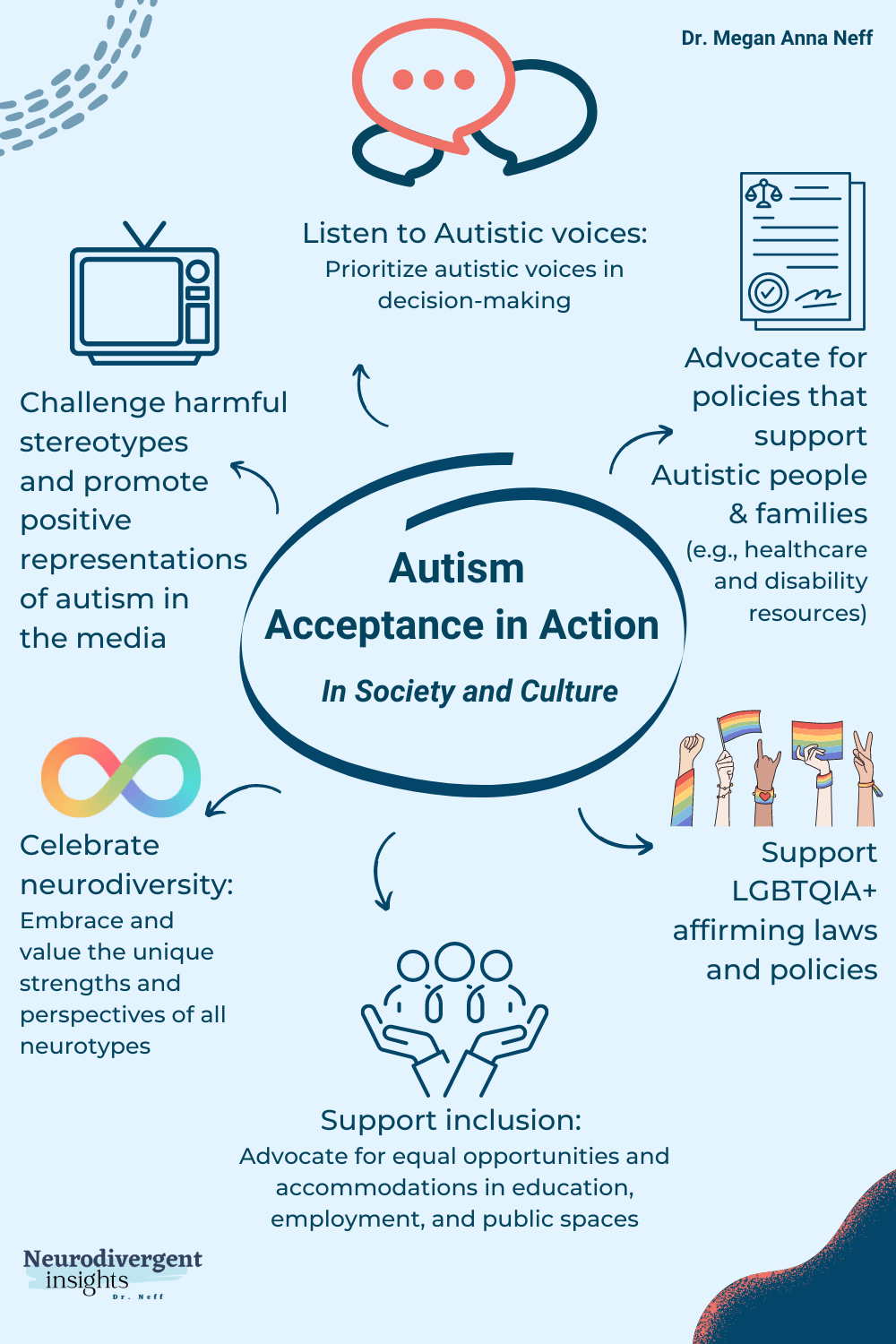Autism Acceptance Month
The district resources included an article on awareness vs. acceptance and why this has been changed.
Here are a few additional resources to highlight the difference.
Autism Acceptance in Action
https://neurodivergentinsights.com/blog/autism-awareness-acceptance
In this blog series, I want to explore concrete ways individuals can practice autism acceptance in different contexts. In this post, I'll share some examples of what it means to embrace and practice autism acceptance. This is by no means an exhaustive list, and there is a wide variance of support needs within the Autistic community. But here are some practical steps to incorporate autism acceptance into action.
Autism Acceptance in Families
Arguably the most critical acceptance starts in the family. Families play an integral role in the well-being of Autistic individuals. How a family does or does not accommodate, support, and accept autism will significantly impact the person's developing sense of self and worth.
Autism acceptance within the family involves recognizing and embracing neurodiversity and honoring each individual's needs and strengths. This includes creating a safe and supportive home environment that allows for sensory regulation, neurodivergent communication, and connection. By embracing and celebrating neurodiversity within the family unit, families can help empower, encourage the integration of Autistic identity, and foster a healthy sense of worth and self-esteem. While not an exhaustive list, here are some practices for creating an inclusive and supportive home environment for autistic individuals and their families.
Ideas for Autism Acceptance in Families:

✦ Normalize stimming (self-stimulatory behavior, such as rocking or hand-flapping), which helps regulate our emotions and focus
✦ Develop a sensory lens and address clashing sensory needs
✦ Create a sensory-safe room or place where the family member can go to sensory-detox
✦ Celebrate and support your loved one's interests and lead with object-based conversations over social-based conversations
✦ Create a predictable routine and environment (Our family has used this huge whiteboard for years to map out the day/weekend and week routines visually)
✦ Get curious and explore! Learn about different neurologies (how different neurotypes process information and how needs may differ)
✦ Support LGBTQIA+ identities (given the high rate of overlap between the autism spectrum, gender spectrum, and sexual diversity-supporting, exploration and integration of LGBTQIA+ identities often plays an important role in supporting the identity integration of the family member)
✦ Explore your own possible neurodivergence! Parents often worry it is "selfish" to explore their neurotype in the aftermath of a child's diagnosis. But this is one of the most powerful things you can do. It may help you to connect with your child, understand them, and for your child to feel understood by a parent in the household.
Autism Acceptance in the Classroom
In the Classroom, Autistic students may have different learning styles and needs compared to their neurotypical peers. Embracing autism acceptance in the classroom means creating an environment that respects and accommodates multiple neurotypes. Ideas for Autism Acceptance in the Classroom:

✦ Normalize stimming (self-stimulatory behavior, such as rocking or hand-flapping), which helps us regulate our emotions and focus
✦ Embrace whole-body (neurodivergent) listening. Whole-body listening for neurodivergent people may involve fidgeting, moving our bodies, doodling, or more
✦ Keep visual clutter to a minimum. For those of us with visual sensitivities, visually chaotic environments can cause cognitive and sensory overload
✦ Encourage sensory regulation by providing sensory breaks and sensory detox areas
✦ Accommodate interoception differences. Create a system that allows students to urgently use the bathroom when needed (vs. being excused)
✦ Provide clear, direct instructions and provide examples and templates when possible
✦ Providing visual aids and written instructions to help with executive functioning difficulties
✦ Allowing for sensory breaks or accommodations such as noise-canceling headphones or fidget toys
✦ Encouraging and incorporating students' special interests
✦ Creating a quiet or low-stimulation area for the student to retreat to if needed
✦ Being mindful of sensory sensitivities when planning classroom activities or events
✦ Support executive functioning by breaking large projects down into smaller tasks and actionable steps
✦ Provide clear, visual schedules and instructions
Resource: Check out everyday regulation for the Whole Body Listening (Neurodivergent edition) poster and other great resources.
Autism Acceptance in The Workplace Autistic people have valuable skills and strengths that can contribute to the workplace. However, these skills are often not fully materialized due to sensory and communication barriers we experience in the workplace. Embracing autism acceptance in the workplace means creating a culture that respects and values a diversity of brain styles. This could involve providing sensory-friendly workspaces, flexible schedules, or alternative communication methods to accommodate different work styles and needs. Ideas for Autism Acceptance in the Workplace:

✦ Offer accommodations such as noise-canceling headphones
✦ Include regular education about neurodiversity in the workplace
✦ Celebrate and utilize employee strengths and interests
✦ Offer autism-specific training for supervisors and managers
✦ Provide clear communication and expectations
✦ Offer flexible work environments and work hours when possible
✦ Create multiple options for communication
✦ Allow for sensory breaks and alternative workspace options
✦ Offering a mentor to new employees for guidance in navigating work culture
✦ When possible, provide advanced notice of schedule changes
Resource: Mentra is an excellent resource for neurodivergent people seeking employment. Mentra is a neurodivergent-friendly work platform that intelligently matches neurodiverse individuals with employers that value their strengths (created by and for neurodivergent people).
Autism Acceptance in Society
Autistic people have a long history of being excluded and marginalized from society. Autistic people face societal barriers and stigma due to a lack of understanding and acceptance of our neurological differences. Embracing autism acceptance in society means challenging these stereotypes and promoting a culture of inclusion and understanding. It means embracing diverse neurotypes as a valid way of being in the world. This could involve advocating for policy changes that support the rights and needs of Autistic individuals, promoting representation of Autistic voices in media and public spaces, or simply educating others about the diversity and benefits of living in a neurodivergent world. It could also include accommodations for sensory needs in public spaces, education and employment opportunities that value neurodiversity, and medical care that respects the autonomy and agency of the Autistic individual. It also means challenging the harmful stereotypes and myths about autism that still persist, such as the idea that Autistic people lack empathy or are unable to form meaningful relationships. By recognizing and celebrating the diversity of autism, we can create a society that is truly inclusive and accepting of neurodiversity.

Ideas for Autism Acceptance in Society:
✦ Support LGBTQIA+ affirming laws and policies
✦ Celebrate neurodiversity: Embrace and value the unique strengths and perspectives of all neurotypes
✦ Challenge harmful stereotypes and promote positive representations of autism in the media
✦ Listen to Autistic voices: Prioritize autistic voices in decision-making
✦ Support inclusion: advocate for equal opportunities and accommodations in education, employment, and public spaces
✦ Advocate for policies that support Autistic people & families (e.g., healthcare and disability resources)
Resource: ASAN is a great resource for getting involved in Autistic self-advocacy and advocacy initiatives. Conclusion: Autism Awareness and Acceptance Autism awareness and acceptance are not just buzzwords or trendy slogans. It’s not a checkbox we complete once a year. It involves ongoing efforts to address internalized and structural ableism and build a more inclusive society. Embracing autism acceptance also means more than just acknowledging the existence of autism. It is a mindset and a way of living that values and affirms the dignity, autonomy, and contributions of Autistic individuals. Autism acceptance in action means actively promoting understanding, accommodation, and inclusion for Autistic people in all areas of life. From family homes to classrooms to workplaces to public spaces, we can all take practical steps to put autism acceptance into action and create a more affirming world for all neurotypes. By putting autism acceptance into action, we can create a world that truly celebrates and values neurodiversity.



No comments:
Post a Comment